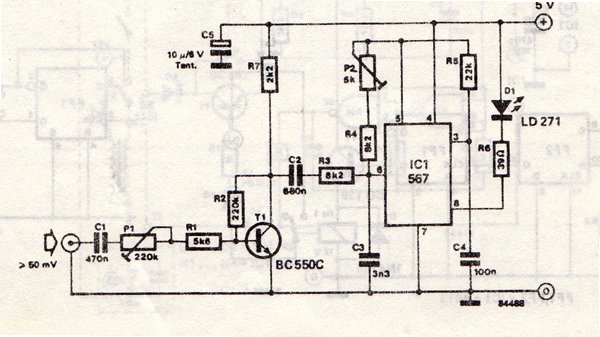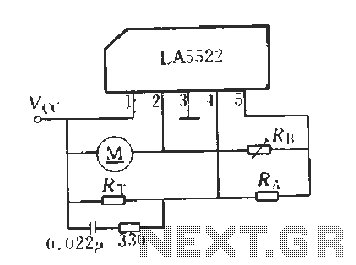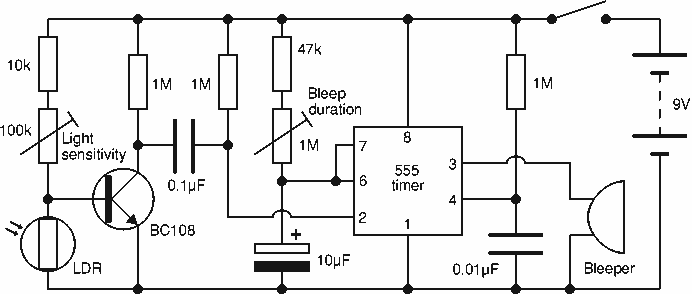
LM567 Infrared Transmitter Circuit

The transmitter is equipped with an LM567 tone decoder circuit. An audio signal (at least 50 mV peak-to-peak) is amplified with a transistor (T1) and then used to modulate IC1. The infrared transmitter frequency is adjusted with potentiometer P2 between 25 and 40 kHz.
The circuit utilizes the LM567, a versatile tone decoder that can demodulate frequency-modulated signals. The audio input, which must be at least 50 mV peak-to-peak, is first amplified by transistor T1. This amplification stage is crucial for ensuring that the audio signal reaches sufficient levels for effective modulation. The output from T1 is then fed into IC1, which serves as the modulator for the infrared transmission.
The modulation process involves varying the frequency of the infrared light emitted by the transmitter in accordance with the amplified audio signal. The frequency of the infrared transmission can be fine-tuned using potentiometer P2, allowing for adjustments in the range of 25 kHz to 40 kHz. This tunability is essential for optimizing the transmission characteristics based on the specific application requirements, such as distance and clarity.
In terms of circuit design, it is critical to ensure that the power supply for the LM567 and T1 is stable and adequately decoupled to prevent noise from affecting performance. Additionally, the layout should minimize interference and maintain signal integrity, particularly in the modulation stage. Proper component selection for T1, such as choosing a transistor with suitable gain and frequency response, will enhance the overall performance of the transmitter.
The resulting infrared signal can be used for various applications, including remote control systems and wireless audio transmission, making this circuit design both functional and adaptable to different use cases.The transmitter is equiped with LM567, tone decoder circuit. Audio signal ( at least 50mVvv ) is amplified with T1 and then it is used to modulate IC1. Infrared transmitter frequency is adjusted with P2 between 25 and 40KHz. 🔗 External reference
The circuit utilizes the LM567, a versatile tone decoder that can demodulate frequency-modulated signals. The audio input, which must be at least 50 mV peak-to-peak, is first amplified by transistor T1. This amplification stage is crucial for ensuring that the audio signal reaches sufficient levels for effective modulation. The output from T1 is then fed into IC1, which serves as the modulator for the infrared transmission.
The modulation process involves varying the frequency of the infrared light emitted by the transmitter in accordance with the amplified audio signal. The frequency of the infrared transmission can be fine-tuned using potentiometer P2, allowing for adjustments in the range of 25 kHz to 40 kHz. This tunability is essential for optimizing the transmission characteristics based on the specific application requirements, such as distance and clarity.
In terms of circuit design, it is critical to ensure that the power supply for the LM567 and T1 is stable and adequately decoupled to prevent noise from affecting performance. Additionally, the layout should minimize interference and maintain signal integrity, particularly in the modulation stage. Proper component selection for T1, such as choosing a transistor with suitable gain and frequency response, will enhance the overall performance of the transmitter.
The resulting infrared signal can be used for various applications, including remote control systems and wireless audio transmission, making this circuit design both functional and adaptable to different use cases.The transmitter is equiped with LM567, tone decoder circuit. Audio signal ( at least 50mVvv ) is amplified with T1 and then it is used to modulate IC1. Infrared transmitter frequency is adjusted with P2 between 25 and 40KHz. 🔗 External reference





